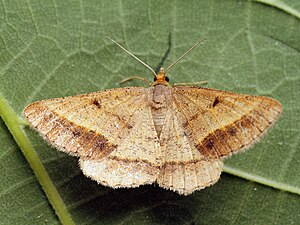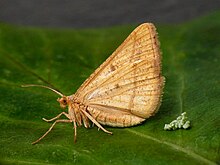Yellowish alfalfa spanner
| Yellowish alfalfa spanner | ||||||||||||
|---|---|---|---|---|---|---|---|---|---|---|---|---|

Yellowish lucerne spider ( Isturgia arenacearia ) |
||||||||||||
| Systematics | ||||||||||||
|
||||||||||||
| Scientific name | ||||||||||||
| Isturgia arenacearia | ||||||||||||
| ( Denis & Schiffermüller , 1775) |
The yellowish lucerne spanner ( Isturgia arenacearia , syn .: Thephrina arenacearia ) is a butterfly from the spanner family (Geometridae). The species name is derived from the Latin word arenaceus meaning "sandy or sand-colored" and refers to the color of the moths.
features
butterfly
The wingspan of the moth is 21 to 27 millimeters. There is no sexual dimorphism between the sexes . The basic color of the upper forewings varies from ocher to honey yellow to orange-brown. The submarginal region has a nut-brown to red-brown color. An indistinct brownish line runs from the dark brown discoidal spot to the inner edge . A brown outer transverse line stands out on the cream-colored upper side of the hind wings. All wing undersides are sand-colored, show a thin, continuous brown outer transverse line and weakly developed discoidal spots.
Caterpillar
Adult caterpillars have a yellow-green color, thin whitish longitudinal lines, a dark-green lined whitish to yellowish lateral stripe and two broad brown longitudinal stripes on the outer head capsule.
Similar species
The basic color of the mouse-gray Esparsette spanner ( Isturgia murinaria ), which is similar to a drawing, tends to be light gray to brownish-gray on the upper sides of the wings.
distribution and habitat
The distribution area of the yellowish alfalfa stretches from East Asia through the temperate zone to Europe. The species did not spread to the west along the Southern Alps chain through South Tyrol and southern Switzerland until the middle of the 20th century . In Germany, observations from the Ore Mountains and Upper Lusatia were reported at the beginning of the 21st century . The main habitat are warm and dry regions, for example steppes and heaths.
Way of life
The moths are mainly nocturnal and fly in two consecutive generations between April and October. At night they appear on artificial light sources . The caterpillars feed on the leaves of butterflies (Faboideae), primarily the red vetch ( Securigera varia ). Regionally, alfalfa ( Medicago sativa ) is preferred as a food crop. The yellowish alfalfa spider is considered a pest in alfalfa cultivation in some southern European countries . The species overwinters in the pupal stage .
Individual evidence
- ^ Arnold Spuler: The butterflies of Europe , Volume 2, E. Schweizerbart'sche Verlagsbuchhandlung, Stuttgart, 1910, p. 117
- ↑ a b c Walter Forster , Theodor A. Wohlfahrt : The butterflies of Central Europe. Volume 5: Spanner. (Geometridae). Franckh'sche Verlagshandlung, Stuttgart 1981, ISBN 3-440-04951-5 , p. 230
- ^ Günter Ebert (Ed.): The butterflies of Baden-Württemberg. 1st edition. Volume 9. Moths VII. Geometridae 2nd part. 1 Ulmer, Stuttgart (Hohenheim), 2003, ISBN 3-8001-3279-6 , pp. 355-356
- ↑ dissemination
- ↑ Josef Wolfsberger: Some new remarkable sites from Switzerland , news sheet of the Bavarian entomologists 6 (4), 1957, pp. 33-37
- ↑ Dieter Stöckel, Hartmut Jornitz & Thomas Sobczyk:: Supplements to the moth fauna of Upper Lusatia (Lepidoptera: Geometridae, Noctuidae & Nolidae) , Entomologische Nachrichten undberichte , 63, 2019, p. 70
literature
- Walter Forster, Theodor A. Wohlfahrt: The butterflies of Central Europe. Volume 5: Spanner. (Geometridae). Franckh'sche Verlagshandlung, Stuttgart 1981, ISBN 3-440-04951-5
Web links
- Lepiforum e. V. - Taxonomy and photos
- insect box - insect box
- leps.it - Moths and Butterflies of Europe and North Africa
- kolumbus.fi - caterpillar
- insecta.pro - Insecta Pro
- fauna-eu - Fauna Europaea

